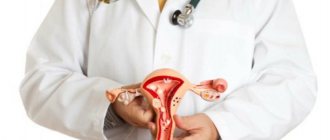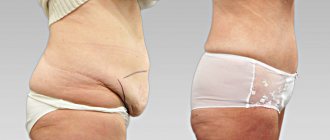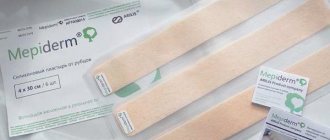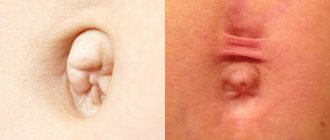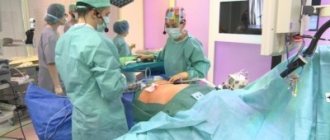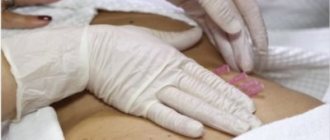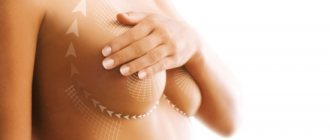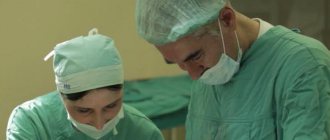Pregnancy is a difficult period for the body, which is characterized by multiple changes. Hormonal levels are disrupted, the position of internal organs changes, and body weight increases. Finally, volumes change, especially in the abdominal area.
After the birth of a child, the following consequences may be observed:
- excess skin;
- fat deposits in the abdomen and sides (flanks);
- separation of the abdominal muscles - diastasis;
- stretch marks.
If a cesarean section was performed, a long postoperative scar is added to the points listed above.
There are many non-surgical ways to restore your figure after childbirth. This is a gradual introduction to systematic sports, skin care using home remedies, and cosmetic procedures aimed at modeling toned body contours. But not all women manage to put their bodies in order in this way.
- First of all, everyone has different genetics. Accordingly, the process of restoring and strengthening the skin goes better for some, and worse for others.
- Secondly, if your skin is prone to stretch marks, you won’t be able to remove them after the fact.
- Thirdly, many women gain weight after childbirth, and the volume does not decrease. Finally, muscle separation can occur even in the most athletic girls, and cannot be eliminated with the help of fitness and proper nutrition.
The surgical method of abdominal correction is called abdominoplasty. This operation is designed to restore the previous shape and volume of the abdomen and sides. Plastic surgery is the most effective way to regain a beautiful figure. Women come to us after one, several or more births, and in all cases, surgery allows them to achieve the desired result.
Why is this operation so in demand? After the birth of a child, a woman worries about changes in her figure, her self-esteem drops, and discord arises in her intimate life with her husband. Abdominoplasty returns everything to its place, and literally too. The plastic surgeon acts as a real “wizard”, giving confidence in himself and his attractiveness.
Who should do it?
Tummy tuck, or rather abdominoplasty, is recommended for women after childbirth who have noticeable stretching and folds of skin in the abdominal area , because not every case allows the patient to put her figure in order through her own efforts.
Then many resort to surgical methods, seeing no other way out of the current situation, and the first thing a competent specialist will recommend after a complaint comes in is, of course, a surgical table. But this does not scare selfless women and girls who deeply dream of a slender waist.
Likewise, plastic surgery is also recommended for people with problems such as :
- Suffering from fat deposits in the abdominal areas.
- Loose skin and/or stretch marks.
- Scars/scars after caesarean section.
The operation is also in demand among young girls who want to get rid of unfortunate fat folds, but it is mainly used to bring the shape to its original state after the birth of a child.
Indications for abdominoplasty after childbirth
A slight weight gain while carrying a child is not yet a reason to resort to plastic surgery. Often a small tummy can be removed with exercise and proper nutrition. But there are changes after childbirth for which tummy tuck is indispensable:
- strongly stretched, loose skin on the abdomen, which, after losing weight, sagged in the form of a skin-fat “apron”;
- small fat deposits in the lower abdomen;
- deformed aponeurosis – development of abdominal diastasis;
- formation of an umbilical hernia;
- change in the localization of the navel - its displacement down or to the sides.
After a difficult birth by caesarean section, abdominoplasty is indicated when a rough, pronounced scar is formed, as well as if the fat layer around the scar is unevenly distributed and causes abdominal deformation.
Contraindications
Remember that you should not immediately rely on the fact that this operation will save you from all the troubles with your body, because even it has contraindications , which you should familiarize yourself with in order to avoid undesirable consequences or complications that arise from neglect of them, especially in recently had childbirth.
They include items such as:
- Breastfeeding period.
- Thyroid diseases.
- Diabetes.
- Kidney or heart failure.
- High (third or fourth) degree obesity.
- Presence of scars.
- Diseases or bleeding disorders.
- Tuberculosis.
- Allergy.
- Diseases of the nervous system.
- Skin diseases.
- Hepatitis.
Liposuction of the abdomen after childbirth: in what cases is it used?
Liposuction of the abdomen after childbirth is a fairly effective procedure if there are problems only with the presence of local accumulation of fat deposits that do not disappear after weight loss. If there are scars or muscle separation, liposuction will only be effective if performed in parallel with abdominoplasty.
Classic liposuction is carried out by inserting a cannula into small incisions, its end is connected to a special device and the fat is removed using vacuum. This type of liposuction has remained the most popular for many years, but there are other methods: laser, tumescent, radio frequency.
However, the recovery period is the same regardless of the type of liposuction used. If you follow medical recommendations, it usually goes away without complications.
Types and methods of plastic surgery, photos
Also, abdominoplasty is distinguished into three main types, differing both in the method of implementation and in the time of rehabilitation of the patient - each of them has its own specific requirements for the client, which should be observed without the slightest deviation from the doctor’s recommendations. Next, we will look at the types of tummy tuck performed after childbirth and their photos.
Endoscopic
- This is the process of making punctures in the navel and above the pubis, into which a specialist inserts medical instruments, after which he achieves a tightening and removes, if necessary, fatty tissue.
- With further actions, he sews the skin together either with ordinary threads or with special ones that can dissolve on their own.
Important! This method is not suitable for people who are clearly overweight or have severe stretch marks and is recommended only for those who have slight sagging in the abdominal cavity!
The entire procedure takes from one to two hours under general anesthesia; the patient must:
- a course of medications is prescribed;
- limit physical activity and nutrition for the first time.
Mini abdominoplasty
Here:
- First of all, suturing of muscles or reduction of hernias is done (if, of course, it was planned), followed by liposuction (again, if it was planned) and finally the removal of excess skin and subcutaneous fat is carried out.
- After which the skin is stretched and stitched with either absorbable or non-absorbable materials, depending on the situation.
- The postoperative wound is disinfected with an antiseptic, after which a sterile bandage is applied and compression garments are put on.
The entire operation takes about two hours, while mini abdominoplasty is the most popular procedure at the moment, allowing you to get rid of moderate abdominal ptosis and many abdominal imperfections .
Classical
This type of abdominoplasty differs from others primarily in that it is more traumatic , has a difficult postoperative period and a high likelihood of complications.
- During it, the patient is placed under deep anesthesia, a transverse incision is made in the pubic area and tissue is removed down to the ribs, and then back down.
- After this, the specialist carries out the necessary manipulations - tightens the muscles, removes excess fatty tissue, hernias, fixes the navel in the right place and stitches the wound with the types of threads already familiar to us from the article.
With the help of classical plastic surgery, you can completely get rid of problems and pathologies on the abdomen after childbirth, but such an operation can cost big problems in the future! It lasts from three to five hours in total.
It is also not recommended to perform such plastic surgery if a woman is planning a second pregnancy in the near future or has the first/second stage of obesity.
Preparatory stage
Preparation for tummy tuck after childbirth consists of several stages. The initial examination is carried out at the initial consultation with the surgeon. The specialist collects anamnesis, assesses the condition of the anterior abdominal wall, diagnoses a hernia and diastasis (if present). The doctor must check the presence of chronic diseases, previous infections and operations. Before abdominoplasty you must:
- take tests for laboratory blood testing to determine blood type, Rh factor, blood clotting level;
- general urine analysis;
- electrocardiogram;
- provide the result of fluorography;
- Ultrasound for suspected hernia and diastasis.
A couple of weeks before surgery, it is recommended to go on a light diet to prepare the intestines and lose some weight. You need to eat low-calorie, low-fat foods, drink more fluids and adhere to a fractional diet. Prohibitions before surgery:
- stop taking blood thinning medications 10 days before;
- do not smoke or drink alcoholic beverages;
- Avoid physical activity for 3 days;
- The day before you cannot eat or drink, the manipulation is carried out on an empty stomach.
We recommend reading: Iodomarin during breastfeeding: can a nursing mother drink it, reviews
Before the operation, you need to take a shower, and for particularly impressionable patients, the doctor prescribes mild sedatives - tincture of motherwort or valerian.
Features of the operation after caesarean section
Doctors do not recommend performing abdominoplasty after a cesarean section for very obvious reasons - this is a rather long, exhausting procedure for the skin and health, anesthesia drugs have a negative impact on the quality of breast milk. Complications become much more likely, body contours may become unnatural, and the figure may become loose.
Experts believe that the optimal period between cesarean and plastic surgery is twelve full months, in other words, you will have to wait a whole year! But on the other hand, the body will completely recover from the surgical intervention, and the lactation process will already be over at that time, which will significantly reduce the risk of disease.
Abdominoplasty immediately after cesarean section is performed under general anesthesia and lasts from one to three hours:
- incisions are made in the navel area;
- after – a long incision in the pubic area;
- the skin is stretched, the excess flap is cut off and stitched with a cosmetic suture just below the bikini line.
After the operation, the patient cannot:
- lift heavy things;
- work;
- be on your feet;
- take a hot bath and visit places such as saunas and steam rooms.
A review of nutrition and diet is required. It is important to remember that tummy tuck after cesarean section is not a method of combating obesity.
Alternative Non-Surgical Methods
Non-surgical tummy tuck methods are considered an alternative to abdominoplasty - they are safe, but not as effective. The most effective include:
- Exercises . A woman can do yoga, swimming, and cardio training. It is important that exercise is regular and combined with proper nutrition. Physical activity on the body after a caesarean section is possible only after 6 months. It is important to obtain permission from a gynecologist to lead an active lifestyle so that training does not negatively affect rehabilitation and lactation.
- Creams. They help strengthen the skin, increase its elasticity, and lose weight. Such products are applied every day in a thin layer using basic massage movements. The results will not be pronounced and will appear only after 6 months from the start of the course. Experts recommend using creams only as an aid; the main emphasis should be on diet and exercise.
- Massage. It is advisable that the procedure be performed by a specialist - he will be able to influence the tightening of the dermis, and not its overstretching. During manipulation, be sure to use cosmetic oils that nourish the cells of the epidermis and accelerate the process of improving its elasticity and firmness. Massage is done in courses of 10-15 sessions, once every 3 months.
Abdominoplasty after cesarean section is the best option for a woman to restore the beauty of her figure after childbirth. The operation is associated with a certain risk, but a competent surgeon and strict adherence to the doctor’s recommendations during recovery are the key to obtaining the desired result.
Rehabilitation
The rehabilitation time depends on the type of plastic surgery, but in general it lasts at least two weeks - during this time the patient is limited even in the choice of underwear (after removing the stitches, for about the first month and a half), because it must be strictly compressive and preferably made from such materials as like nylon or spandex, a woman is also limited in nutrition and physical activity.
- On the first day, the patient is transferred to the intensive care unit under the supervision of doctors. This will eliminate possible “surprises” with health and stitches.
- On the second day, she is already transferred to a regular ward, where she stays on average from two to seven days, depending on her condition, and is discharged to a day hospital.
- On the twelfth to fourteenth day , if no complications were identified, the surgeon successfully removes the drainage and removes the sutures.
- This is followed by therapeutic and preventive measures aimed at preventing the occurrence of complications, which lasts approximately three weeks from the end of the operation.
We should not forget that in the early postoperative period it is strictly forbidden to take a bath, eat heavy food and physically strain the body!
Coordinate all your actions with your doctors!
Myostimulation
Myostimulation or electrical stimulation is a hardware procedure for body correction using electric current. Weak impulses pass through the body to the muscles, causing them to contract intensely.
We recommend reading: How long does discharge last after childbirth: normal and abnormalities
Myostimulation can be carried out locally or in several problem areas at once
The first mention of the use of electric current for medical purposes dates back to the era of Ancient Rome (63 AD). Scribonius Largus, an ancient Roman physician, described in his writings that in order to relieve pain (headache, joint pain), you need to stand on an electric ramp.
Initially, myostimulation was used for the rehabilitation of patients who cannot move independently and perform physical therapy. Currently, it is included in the list of methods of hardware weight loss, in particular for the abdominal area. A course of procedures will remove excess fat and work even deep, hard-to-reach muscles. Add active sports, and very soon you will see the desired abs. The result is noticeable after 4-5 sessions. Myostimulation is often prescribed to women after childbirth: it can quickly restore weakened muscles of the anterior abdominal wall, tighten sagging skin, and improve blood circulation.
Execution steps
- The work area is cleaned and degreased. You can exfoliate at home before the procedure.
- Conductive gel is applied.
- Electrodes are applied, the location scheme is selected individually.
- The specialist selects the intensity mode and turns on the myostimulator.
- After 20–30 minutes, the electrodes are removed, the gel is washed off, and a moisturizer is applied to the skin.
For maximum effectiveness, a course of 10–15 procedures with a gradual increase in the intensity of exposure is indicated. At least a day should pass between sessions; this time is necessary for the muscles to recover. You can repeat the course after six months.
Contraindications
- Heart diseases.
- Blood diseases, blood clots in blood vessels.
- Oncology.
- Endocrine system disruptions.
- Inflammation and chronic diseases in the acute stage.
- Infectious diseases.
- Wounds, abrasions, scars from surgery, after which less than 10 months have passed, in the places where the electrodes will be located.
- The presence of an intrauterine device, pacemaker, and other implants.
- Stones in the kidneys.
- Pregnancy and lactation.
Advantages
- In just a few sessions you will be back in tone.
- The “orange peel” is significantly reduced, the volumes are reduced (up to 2–5 cm).
- The skin becomes firm and elastic under the influence of electrical impulses.
- After the procedure, you feel a surge of strength and energy due to the production of endorphins from muscle work.
- The technique is suitable for people whom doctors prohibit from going to the gym due to problems with the musculoskeletal system.
Flaws
- Current does not pass through fat well, so if you have a lot of excess weight, it is better to choose another method for losing weight.
- For a long-lasting effect, you must complete the entire course prescribed by a specialist. The visible effect after the first session is due to the outflow of fluid, which will quickly return to its place.
- After several treatments, the muscles may stop responding to the current. This means that they need a real load.
Complications
Complications after tummy tuck are divided into two types: general and local . Common ones include:
- Swelling of the respiratory tract.
- Development of intra-abdominal hypertension.
- Hypostatic pneumonia.
- Abdominal syndrome.
Local:
- Seroma.
- Severe suppuration of the wound.
- Swelling of soft tissues.
- Seam rupture.
- Loss of sensation.
Complications can always be prevented if you follow a few simple rules - you should forget about smoking, alcohol, junk food at least a month before surgery, follow the recommendations of doctors, some of which are presented in the “rehabilitation” paragraph of our article, and observe bed rest.
How to tighten your skin at home?
To tighten your tummy without surgery, you should perform a number of physical exercises:
- wall squats - the exercise is performed like regular squats, but with a straight back pressed tightly against the wall;
- plank - the body is held on arms bent at the elbows and toes for the maximum amount of time;
- on the press - lying on your back, you should raise your body, while your legs are firmly pressed with your feet to the floor;
- swings - you should sharply throw your arms to the sides, while turning your body alternately left and right.
In addition, you must follow a diet - try to eat no more than one and a half thousand calories per day. The menu must contain protein foods, and it is advisable to completely exclude quickly digestible carbohydrates.
It is important to drink enough fluids - if the body receives less than 1.5 liters of water per day, the process of tightening the skin on the abdomen may be delayed.
- https://BezDiastaza.ru/plastika-zhivota-posle-rodov
- https://plasticology.ru/abdominoplastika/posle-rodov/
- https://beautyexpert.pro/hirurgiya/abdominoplastika/posle-rodov.html
- https://iplastica.ru/korrekciya-figury/zhivot/plastika-zhivota-posle-rodov-foto-do-i-posle.html
- https://kesarevo.online/abdominoplastika-zhivota-posle-kesareva/
- https://nkclinica.ru/korrekciya-figury/abdominoplastika-posle-rodov.html
results
The result is usually not long in coming - it is visible instantly, but you will be able to boast of a slender tummy in about six months, when the swelling has completely subsided and a scar has formed at the site of the suture. Until this moment, it simply won’t look as aesthetically pleasing as we would like, not to mention walking around in a tank top. However, believe me, a slim, flat stomach will be at your disposal!
Maintaining the result also depends on your actions; if you do everything correctly, it will stay with you for life.
The results, consequences and ways to avoid complications after abdominoplasty are discussed in this article.
Efficiency
Abdominoplasty is more justified for women who have given birth repeatedly. The effectiveness of the operation depends on many factors and rules that the patient must follow.
If the level of the clinic in which the operation was carried out is distinguished by the high quality of the work of surgeons, the latest equipment, innovative methods of diagnosis and procedures, then the effectiveness of plastic surgery will not be long in coming.
All patients wishing to undergo such a procedure need to understand that the duration of the effect also depends on their own contribution to the preservation of the figure after the operation.
After it, you need to wear a specialized bandage for a period of 1 to 1.5 months. Compliance with a rational daily routine and nutrition is another component of the effectiveness of the postoperative period for abdominoplasty.
Scar placement
The main complaints of patients after abdominoplasty are related to the visibility of scars. The level of the scar is important so that the patient can hide it under underwear
The height and distance between the navel and pubis should also be taken into account. If the cut is too high, the bikini or underwear will not cover it
No one can predict how wounds will heal in any given patient.
The keloid scar extends beyond the boundaries of the initial incision. A hypertrophic scar is a thickened scar in the area of the incision. Hypertrophic scars can typically form as a result of excessive suture tension, insufficient suturing, infection, poor healing from medical problems, or insufficient blood supply. Hypertrophic scars after abdominoplasty are extremely rare. Correcting hypertrophic scars involves identifying the cause of the scarring and then correcting the scar. This procedure can usually be performed under local anesthesia.
Considered imperfect:
- very thin and wide scars,
- asymmetrical scars,
- discolored scars.
Very thin and wide scars usually indicate that the connective tissue underlying the skin has taken part in healing the incisions. This may be the result of poor skin quality. Correcting these scars involves removing the thin scar and adjusting the underlying connective tissue. Asymmetrical scars can form if one side of the abdomen has previous scars. Correction of scars is possible 6-12 months to a year after surgery. Wide scars can be adjusted; scars that are too tall can be moved. However, a complete revision abdominoplasty is often required to correct significant scarring.
Preparation for surgery and rehabilitation period
Women who have recently given birth to a child are usually not ready to risk their health even for the sake of their figure. Because of this, they are very attentive to recommendations for preparation and rehabilitation after surgery. There is nothing to worry about, because the result of liposuction obtained by the patient often depends on proper preparation and rehabilitation.
You need to be very careful when choosing a doctor. The outcome of the intervention depends on his qualifications; doctors with extensive experience are less likely to develop postoperative complications. That is why choosing a doctor is a separate point of preparation, the most important.
Otherwise, preparing for liposuction is not difficult. First, the woman undergoes a series of tests. Based on them, the doctor concludes whether the patient has contraindications to the intervention. Then general recommendations are given regarding nutrition, fluid intake, and avoidance of harmful vaccinations.
Postoperative rehabilitation is another stage that cannot be ignored. A young mother who has undergone liposuction will have to limit physical activity for a week after leaving the clinic. This can significantly complicate caring for the baby, and therefore it is worth enlisting the support of relatives in advance.
Rehabilitation always additionally includes limiting emotional stress and wearing compression garments. Underwear helps the skin to tighten properly and promotes uniform redistribution of remaining fatty tissues.
